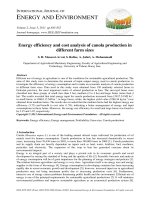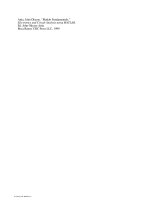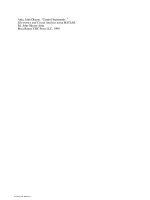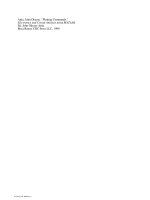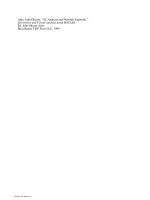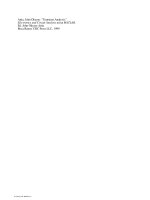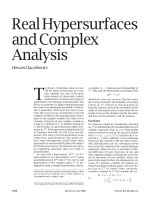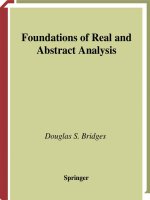real and complex analysis
Bạn đang xem bản rút gọn của tài liệu. Xem và tải ngay bản đầy đủ của tài liệu tại đây (6.55 MB, 433 trang )
REAL AND COMPLEX ANALYSIS
www.pdfgrip.com
www.pdfgrip.com
REAL AND
COMPLEX
ANALYSIS
Third Edition
Walter Rudin
Professor of Mathematics
University of Wisconsin, M,adison
McGraw..HiII Book Company
New York St. Louis San Francisco Auckland Bogota Hamburg
London Madrid Mexico Milan Montreal New Delhi
Panama Paris Sao Paulo Singapore Sydney Tokyo Toronto
www.pdfgrip.com
REAL AND COMPLEX ANALYSIS
INTERNATIONAL EDITION 1987
Exclusive rights by McGraw-Hili Book Co., Singapore
for manufacture and export. This book cannot be re-exported
from the country to which it is consigned by McGraw-HilI.
012345678920BJE9876
Copyright © 1987, 1974, 1966 by McGraw-Hili, Inc.
All rights reserved. No part of this publication may be
reproduced or distributed in any form or by any means,
or stored in a data base or a retrieval system, without
the prior written permission of the publisher.
This book was set in Times Roman.
The editor was Peter R. Devine.
The production supervisor was Diane Renda.
Library of Congress Cataloging-in-Publication Data
Rudin, Walter, 1921 Real and complex analysis.
Bibliography: p.
Includes index.
1. Mathematical analysis. I. Title.
QA300.R82 1987 515 86-7
ISBN 0-07-054234-1
When ordering this title use ISBN 0-07-100276-6
Printed in Singapore
www.pdfgrip.com
ABOUT THE AUTHOR
Walter Rudin is the author of three textbooks, Principles of Mathematical
Analysis, Real and Complex Analysis, and Functional Analysis, whose widespread
use is illustrated by the fact that they have been translated into a total of 13
languages. He wrote the first of these while he was a C.L.E. Moore Instructor at
M.I.T., just two years after receiving his Ph.D. at Duke University in 1949. Later
he taught at the University of Rochester, and is now a Vilas Research Professor
at the University of Wisconsin-Madison, where he has been since 1959.
He has spent leaves at Yale University, at the University of California in La
Jolla, and at the University of Hawaii.
His research has dealt mainly with harmonic analysis and with complex variables. He has written three research monographs on these topics, Fourier
Analysis on Groups, Function Theory in Polydiscs, and Function Theory in the
U nit Ball of CD.
www.pdfgrip.com
www.pdfgrip.com
CONTENTS
Preface
xiii
Prologue: The Exponential Function
Chapter 1
Abstract Integration
Set-theoretic notations and terminology
The concept of measurability
Simple functions
Elementary properties of measures
Arithmetic in [0, 00]
Integration of positive functions
Integration of complex functions
The role played by sets of measure zero
Exercises
Chapter 2
Positive Borel Measures
Vector spaces
Topological preliminaries
The Riesz representation theorem
Regularity properties of Borel measures
Lebesgue measure
Continuity properties of measurable functions
Exercises
Chapter 3
5
6
8
15
16
18
19
24
27
31
33
33
35
40
47
49
55
57
LP-Spaces
61
Convex functions and inequalities
The LP-spaces
Approximation by continuous functions
Exercises
61
65
69
71
vii
www.pdfgrip.com
viii
CONTENTS
Chapter 4
Chapter 5
Chapter 6
Chapter 7
Chapter 8
Chapter 9
Elementary Hilbert Space Theory
76
Inner products and linear functionals
Orthonormal sets
Trigonometric series
Exercises
76
82
88
92
Examples of Banach Space Techniques
95
Banach spaces
Consequences of Baire's theorem
Fourier series of continuous functions
Fourier coefficients of LI-functions
The Hahn-Bana.eh theorem
An abstract approach to the Poisson integral
Exercises
95
97
100
103
104
108
112
Complex Measures
Total variation
Absolute continuity
Consequences of the Radon-Nikodym theorem
Bounded linear functionals on LP
The Riesz representation theorem
Exercises
116
116
120
124
126
129
132
Differentiation
135
Derivatives of measures
The fundamental theorem of Calculus
Differentiable transformations
Exercises
135
144
150
156
Integration on Product Spaces
Measurability on cartesian products
Product measures
The Fubini theorem
Completion of product measures
Convolutions
Distribution functions
Exercises
160
160
163
164
167
170
172
174
Fourier Transforms
178
Formal properties
The inversion theorem
The Plancherel theorem
The Banach algebra LI
Exercises
178
180
185
190
193
www.pdfgrip.com
CONTENTS ix
Chapter 10
Chapter 11
Chapter 12
Chapter 13
Chapter 14
Elementary Properties of Holomorphic
Functions
Complex differentiation
Integration over paths
The local Cauchy theorem
The power series representation
The open mapping theorem
The global Cauchy theorem
The calculus of residues
Exercises
196
196
200
204
208
214
217
224
227
Harmonic Functions
231
The Cauchy-Riemann equations
The Poisson integral
The mean value property
Boundary behavior of Poisson integrals
Representation theorems
Exercises
231
233
237
239
245
249
The Maximum Modulus Principle
Introduction
The Schwarz lemma
The Phragmen-LindelOf method
An interpolation theorem
A converse of the maximum modulus theorem
Exercises
253
253
254
256
260
262
264
Approximation by Rational Functions
266
Preparation
Runge's theotem
The Mittag-Lerner theorem
Simply connected regions
Exercises
266
270
273
274
276
Conformal Mapping
278
278
279
281
282
285
289
291
293
Preservation of angles
Linear fractional transformations
Normal families
The Riemann mapping theorem
The class [I'
Continuity at the boundary
Conformal mapping of an annulus
Exercises
www.pdfgrip.com
x CONTENTS
Chapter 15
Zeros of Holomorphic Functions
Infinite products
The Weierstrass factorization theorem
An interpolation problem
Jensen's formula
Blaschke products
The Miintz-Szasz theorem
Exercises
Chapter 16
Chapter 17
Analytic Continuation
319
Regular points and singular points
Continuation along curves
The monodron;Iy theorem
Construction of a modular function
The Picard theorem
Exercises
319
323
326
328
331
332
HP-Spaces
335
335
337
341
342
346
350
352
Subharmonic functions
The spaces HP and N
The theorem of F. and M. Riesz
Factorization "theorems
The shift operator
Conjugate functions
Exercises
Chapter 18
Elementary Theory of Banach Algebras
Introduction
The invertible elements
Ideals and homomorphisms
Applications
Exercises
Chapter 19
Holomorphic Fourier Transforms
Introduction
Two theorems of Paley and Wiener
Quasi-analytic classes
The Denjoy-Carleman theorem
Exercises
Chapter 20
298
298
301
304
307
310
312
315
Uniform Approximation by Polynomials
Introduction
Some lemmas
Mergelyan's theorem
Exercises
www.pdfgrip.com
356
356
357
362
365
369
371
371
372
377
380
383
386
386
387
390
394
CONTENTS
xi
Appendix: Hausdorff's Maximality Theorem
395
Notes and Comments
397
Bibliography
405
List of Special Symbols
407
Index
409
www.pdfgrip.com
www.pdfgrip.com
PREFACE
This book contains a first-year graduate course in which the basic techniques and
theorems of analysis are presented in such a way that the intimate connections
between its various branches are strongly emphasized. The traditionally separate
subjects of "real analysis" and "complex analysis" are thus united; some of the
basic ideas from functional analysis are also included.
Here are some examples of the way in which these connections are demonstrated and exploited. The Riesz representation theorem and the Hahn-Banach
theorem allow one to " guess" the Poisson integral formula. They team up in the
proof of Runge's theorem. They combine with Blaschke's theorem on the zeros of
bounded holomorphic functions to give a proof of the Miintz-Szasz theorem,
which concerns approximation on an interval. The fact that 13 is a Hilbert space
is used in the proof of the Radon-Nikodym theorem, which leads to the theorem
about differentiation of indefinite integrals, which in turn yields the existence of
radial limits of bounded harmonic functions. The theorems of Plancherel and
Cauchy combined give a theorem of Paley and Wiener which, in turn, is used in
the Denjoy-Carleman theorem about infinitely differentiable functions on the real
line. The maximum modulus theorem gives information about linear transformations on fl'-spaces.
Since most of the results presented here are quite classical (the novelty lies in
the arrangement, and some of the proofs are new), I have not attempted to document the source of every item. References are gathered at the end, in Notes and
Comments. They are not always to the original sources, but more often to more
recent works where further references can be found. In no case does the absence
of a reference imply any claim to originality on my part.
The prerequisite for this book is a good course in advanced calculus
(settheoretic manipulations, metric spaces, uniform continuity, and uniform
convergence). The first seven chapters of my earlier book" Principles of Mathematical Analysis" furnish sufficient preparation.
xiii
www.pdfgrip.com
xiv
PREFACE
Experience with the first edition shows that first-year graduate students can
study the first 15 chapters in two semesters, plus some topics from 1 or 2 of the
remaining 5. These latter are quite independent of each other. The first 15 should
be taken up in the order in which they are presented, except for Chapter 9, which
can be postponed.
The most important difference between this third edition and the previous
ones is the entirely new chapter on differentiation. The basic facts about differentiation are now derived fro~ the existence of Lebesgue points, which in turn is an
easy consequence of the so-called "weak type" inequality that is satisfied by the
maximal functions of measures on euclidean spaces. This approach yields strong
theorems with minimal effort. Even more important is that it familiarizes students with maximal functions,' since these have become increasingly useful in
several areas of analysis.
One of these is the study of the boundary behavior of Poisson integrals. A
related one concerns HP-spaces. Accordingly, large parts of Chapters 11 and 17
were rewritten and, I hope, simplified in the process.
I have also made several smaller changes in order to improve certain details:
For example, parts of Chapter 4 have been simplified; the notions of equicontinuity and weak convergence are presented in more detail; the boundary
behavior of conformal maps is studied by means of Lindelof's theorem about
asymptotic valued of bounded holomorphic functions in a disc.
Over the last 20 years, numerous students and colleagues have offered comments and criticisms concerning the content of this book. I sincerely appreciated
all of these, and have tried to follow some of them. As regards the present edition,
my thanks go to Richard Rochberg for some useful last-minute suggestions, and I
especially thank Robert Burckel for the meticulous care with which he examined
the entire manuscript.
Walter Rudin
www.pdfgrip.com
PROLOGUE
THE EXPONENTIAL FUNCTION
This is the most important function in mathematics. It is defined, for every complex number z, by the formula
00
exp (z) =
z"
L ,.
(1)
,,=0 n.
The series (1) converges absolutely. for every z and converges uniformly on every
bounded subset of the complex plane. Thus exp is a continuous function. The
absolute convergence of (1) shows that the computation
00
ak
00
L -k' L
k=O .
m=O
,= L ,
bm
m.
00
,,=0
1"
n!
L k'(
n. k=O . n -
k)' akb,,-k=
.
00
(a+bt
,,=0
n.
L
,
is correct. It gives the important addition formula
exp (a) exp (b)
= exp (a + b),
(2)
valid for all complex numbers a and b.
We define the number e to be exp (1), and shall usually replace exp (z) by the
customary shorter expression e%. Note that eO = exp (0) = 1, by (1).
Theorem
(a) For every complex z we have e% =I: O.
(b) exp is its own derivative: exp' (z) = exp (z).
1
www.pdfgrip.com
2
REAL AND COMPLEX ANALYSIS
(c) The restriction of exp to the real axis is a monotonically increasing positive
function, and
e"'-+
00
as x-+
00,
(d) There exists a positive number n such that e1ti/ 2 = i and such that eZ = 1 if
and only if z/(2ni) is an integer.
(e) exp is a periodic function, with period 2ni.
(f) The mapping t-+ e it maps the real axis onto the unit circle.
(g) If w is a complex number and w =I- 0, then w = eZ for some z.
PROOF
By (2), eZ • e- z = eZ -
, ()
I.
exp z = 1m
exp (z
z
= eO = 1. This implies (a). Next,
+ h)h - exp (z) = exp (z) I.1m exp (h)
- 1
()
h
= exp z.
h-O
h-O
The first of the above equalities is a matter of definition, the second follows
from (2), and the third from (1), and (b) is proved.
That exp is monotonically increasing on the positive real axis, and that
e"'-+ 00 as x-+ 00, is clear from (1). The other assertions of (c) are consequences of e'" . e-'" = 1.
For any real number t, (1) shows that e- it is the complex conjugate of e it .
Thus
or
(t real).
(3)
In other words, if t is real, eit lies on the unit circle. We define cos t, sin t to
be the real and imaginary parts of eit :
cos t
= Re
(t real).
[eit],
(4)
If we differentiate both sides of Euler's identity
eit = cos t
+ i sin
(5)
t,
which is equivalent to (4), and if we apply (b), we obtain
cos' t
+ i sin' t =
ie it
= - sin t + i cos
t,
so that
cos'
= -sin,
sin' = cos.
(6)
The power series (1) yields the representation
t2
cos t = 1 - 2!
t
t
+ -4!
- -6!
+ ... .
4
6
www.pdfgrip.com
(7)
PROLOGUE: THE EXPONENTIAL FUNCTION
3
Take t = 2. The terms of the series (7) then decrease in absolute value (except
for the first one) and their signs alternate. Hence cos 2 is less than the sum of
the first three terms of (7), with t = 2; thus cos 2 < -t. Since cos 0 = 1 and
cos is a continuous real function on the real axis, we conclude that there is a
smallest positive number to for which cos to = O. We define
n = 2t o .
It follows from (3) and (S} that sin to
sin' (t)
(8)
= ± 1. Since
= cos
t> 0
on the segment (0, to) and since sin 0 = 0, we have sin to > 0, hence sin to =
1, and therefore
e 1tI / 2
It follows that
e 1t1
=
i2
= -1,
= i.
e21t1
= (_1)2 = 1, and then
(9)
e 21tln
= 1 for
every integer n. Also, (e) follows immediately:
(10)
If z = x + iy, x and y real, then e Z = eXe lY ; hence 1e Z 1 = eX. If e Z = 1, we therefore must have eX = 1, so that x = 0; to prove that yl2n must be an integer, it
is enough to show that ely "# 1 if 0 < y < 2n, by (10).
Suppose 0 < y < 2n, and
ely / 4
= u + iv
(u and v real).
(11)
Since 0 < yl4 < n12, we have u > 0 and v > O. Also
+ v4 + 4iuv(u 2 - v2 ).
(12)
The right side of (12) is real only if u 2 = v2 ; since u2 + v2 = 1, this happens
ely
= (u
only when u2 = v2 =
+ iV)4 =
u4 - 6U 2 V2
t, and then (12) shows that
ely
= -1"# 1.
This completes the proof of (d).
We already know that t-+ elt maps the real axis into the unit circle. To
prove (f), fix w so that 1wi = 1; we shall show that w = elt for some real t.
Write w = u + iv, u and v real, and suppose first that u ~ 0 and v ~ O. Since
u :::;; 1, the definition of n shows that there exists a t, 0 :::;; t :::;; n12, such that
cos t = u; then sin 2 t = 1 - u2 = v 2 , and since sin t ~ 0 if 0:::;; t :::;; n12, we
have sin t = v. Thus w = elt.
If u < 0 and v ~ 0, the preceding conditions are satisfied by - iw. Hence
- iw = e lt for some real t, and w = e l (t+1t/2). Finally, if v < 0, the preceding
two cases show that - w = e lt for some real t, hence w = ei(t+1t). This completes the proof of (f).
If w "# 0, put IX = wi 1w I. Then w = 1wi IX. By (c), there is a real x such
that 1 wi = eX. Since 1IX 1 = 1, (f) shows that IX = ely for some real y. Hence
w = ex+ly. This proves (g) and completes the theorem.
IIII
www.pdfgrip.com
4
REAL AND COMPLEX ANALYSIS
We shall encounter the integral of (1 + X 2 )-1 over the real line. To evaluate
it, put tp(t) = sin tlcos t in (-nI2, nI2). By (6), tp' = 1 + tp2. Hence tp is a monotonically increasing mapping of ( -nI2, n12) onto ( - 00, (0), and we obtain
f
oo
-00
~ = fft/2
1+
X
-ft/2
tp'(t) :t = f"/2 dt = n.
1 + tp (t)
-ft/2
www.pdfgrip.com
CHAPTER
ONE
ABSTRACT INTEGRATION
Toward the end of the nineteenth century it became clear to many mathematicians that the Riemann integral (about which one learns in calculus courses)
should be replaced by some other type of integral, more general and more flexible, better suited for dealing with limit processes. Among the attempts made in
this direction, the most notable ones were due to Jordan, Borel, W. H. Young,
and Lebesgue. It was Lebesgue's construction which turned out to be the most
successful.
In brief outline, here is the main idea: The Riemann integral of a function!
over an interval [a, b] can be approximated by sums of the form
n
L !(t;)m(E;)
;= 1
where E 1 , ... , En are disjoint intervals whose union is [a, b], m(E;) denotes the
length of E;, and t; E E; for i = 1, ... , n. Lebesgue discovered that a completely
satisfactory theory of integration results if the sets E; in the above sum are
allowed to belong to a larger class of subsets of the line, the so-called
"measurable sets," and if the class of functions under consideration is enlarged to
what he called "meas\lrable functions." The crucial set-theoretic properties
involved are the following: The union and the intersection of any countable
family of measurable sets are measurable; so is the complement of every measurable set; and, most important, the notion of-" length" (now called "measure")
can be extended to them in such a way that
5
www.pdfgrip.com
6
REAL AND COMPLEX ANALYSIS
for every countable collection {Ei} of pairwise disjoint measurable sets. This property of m is called countable additivity.
The passage from Riemann's theory of integration to that of Lebesque is a
process of completion (in a sense which will appear more precisely later). It is of
the same fundamental importance in analysis as is the construction of the real
number system from the rationals.
The above-mentioned measure m is of course intimately related to the
geometry of the real line. In this chapter we shall present an abstract (axiomatic)
version of the Lebesgue integral, relative to any countably additive measure on
any set. (The precise definitions follow.) This abstract theory is not in any way
more difficult than the special case of the real line; it shows that a large part of
integration theory is independent of any geometry (or topology) of the underlying
space; and, of course, it gives us a tool of much wider applicability. The existence
of a large class of measures, among them that of Lebesgue, will be established in
Chap. 2.
Set-Theoretic Notations and Terminology
1.1 Some sets can be described by listing their members. Thus {Xl' ... , xn} is the
set whose members are Xl> ••. , Xn; and {x} is the set whose only member is x.
More often, sets are described by properties. We write
{X: P}
for the set of all elements X which have the property P. The symbol 0 denotes
the empty set. The words collection, family, and class will be used synonymously
with set.
We write X E A if X is a member of the set A; otherwise X rt A. If B is a subset
of A, i.e., if X E B implies x E A, we write· B c: A. If B c: A and A c: B, then
A = B. If B c: A and A :I: B, B is a proper subset of A. Note that 0 c: A for every
set A.
A u B and A n B are the union and intersection of A and B, respectively. If
{A .. } is a collection of sets, where IX runs through some index set I, we write
UA .
and
.. el
for the union and intersection of {A .. } :
U A .. =
{x: x
E
A .. for at least one
nA .. = {x: x
E
A .. for every
IX E
I}
.. el
IX E
I} .
.. el
If I is the set of all positive integers, the customary notations are
U An
and
n=l
www.pdfgrip.com
ABSTRACT INTEGRAnON
7
If no two members of {All} have an element in common, then {All} is a
disjoint collection of sets:
We write A - B = {x: x E A, x ~ B}, and denote the complement of A by A C
whenever it is clear from the context with respect to which larger set the complement is taken.
The cartesian product Al x ... x An of the sets AI' ... , An is the set of all
ordered n-tuples (aI' ... , an) where ai E Ai for i = 1, ... , n.
The real line (or real number system) is Rl, and
(k factors).
The extended real number system is Rl with two symbols, 00 and - 00, adjoined,
and with the obvious ordering. If - 00 :s; a :s; b :s; 00, the interval [a, b] and the
segment (a, b) are defined to be
[a, b] = {x: a :s; x :s; b},
(a, b)
= {x: a < x < b}.
We also write
[a, b)
= {x: a :s; x < b},
(a, b] = {x: a < x :s; b}.
If E c [ - 00, 00] and E i= 0, the least upper bound (supremum) and greatest lower bound (infimum) of E exist in [ - 00, 00] and are denoted by sup E and
inf E.
Sometimes (but only when sup E E E) we write max E for sup E.
The symbol
f:X-Y
means thatfis afunction (or mapping or transformation) of the set X into the set
Y; i.e., f assigns to each x E X an element f(x) E Y. If A c X and BeY, the
image of A and the inverse image (or pre-image) of Bare
= {y: y = f(x) for some x
f- 1(B) = {x:f(x) E B}.
Note thatf-l(B) may be empty even when B i= 0.
f(A)
E
A},
The domain offis X. The range offisf(X).
Iff(X) = Y,fis said to map X onto Y.
We writef- 1(y), instead off- 1({y}), for every y E Y. Iff-l(y) consists of at
most one point, for each y E Y,f is said to be one-to-one. Iff is one-to-one, then
f- 1 is a function with domainf(X) and range X.
If f: X - [ - 00, 00] and E c X, it is customary to write supx e E f(x) rather
than sup f(E).
If f: X - Y and g: Y - Z, the composite function g f: X - Z is defined by
the formula
0
(g 0 f)(x) = g(f(x»
(x EX).
www.pdfgrip.com
8
REAL AND COMPLEX ANALYSIS
If the range ofJ lies in the real line (or in the com plex plane), then J is said to
be a real Junction (or a complex Junction). For a complex function/, the statement
"J;;::. 0" means that all valuesJ(x) ofJare nonnegative real numbers.
The Con~ept of Measurability
The class of measurable functions plays a fundamental role in integration theory.
It has some basic properties in common with another most important class of
functions, namely, the continuous ones. It is helpful to keep these similarities in
mind. Our presentation is therefore organized in such a way that the analogies
between the concepts topological space, open set, and continuous Junction, on the
one hand, and measurable space, measurable set, and measurable Junction, on the
other, are strongly emphasized. It seems that the relations between these concepts
emerge most clearly when the setting is quite abstract, and this (rather than a
desire for mere generality) motivates our approach to the subject.
1.2 Definition
(a) A collection 't of subsets of a set X is said to be a topology in X if 't has
the following three properties:
(i) 0 E 't and X E 'to
(ii) If V; E dor i = 1, ... , n, then VI n V2 n ... n v.. E 'to
(iii) If {~} is an arbitrary collection of members of't (finite, countable, or
uncountable), then Ua ~ E 'to
(b) If 't is a topology in X, then X is called a topological space, and the
members of't are called the open sets in X.
(c) If X and Yare topological spaces and ifJis a mapping of X into Y, then
J is said to be continuous provided that J -l( V) is an open set in X for
every open set V in Y.
1.3 Definition
(a) A collection IDl of subsets of a set X is said to be a a-algebra in X if IDl
has the following properties:
(i) X E IDl.
(ii) If A E IDl, then AC
X.
(iii) If A
= U:,= I
E
IDl, where ACis the complement of A relative to
An and if An
E
IDl for n
= 1,2, 3, ... , then A E IDl.
(b) If IDl is a a-algebra in X, then X is called a measurable space, and the
.
members of IDl are called the measurable sets in X.
(c) If X is a measurable space, Y is a topological space, andJis a mapping
of X into Y, then J is said to be measurable provided that J -1(V) is a
measurable set in X for every open set V in Y.
www.pdfgrip.com
ABSTRACT INTEGRA nON
9
It would perhaps be more satisfactory to apply the term" measurable space"
to the ordered pair (X, rol), rather than to X. After all, X is a set, and X has not
been changed in any way by the fact that we now also have a u-algebra of its
subsets in mind. Similarly, a topological space is an ordered pair (X, 'tf But if this
sort of thing were systematically done in all mathematics, the terminology would
become awfully cumbersome. We shall discuss this again at somewhat greater
length in Sec. 1.21.
1.4 Comments on Definition 1.2 The most familiar topological spaces are the
metric spaces. We shall assume some familiarity with metric spaces but shall give
the basic definitions, for the sake of completeness.
A metric space is a set X in which a distance function (or metric) p is defined,
with the following properties:
(a)
(b)
(c)
(d)
0::;; p(x, y) < 00 for all x and y E X.
p(x, y) = 0 if and only if x = y.
p(x, y) = p(y, x) for all x and y E X.
p(x, y) ::;; p(x, z) + p(z, y) for all x, y, and z E X.
Property (d) is called the triangle inequality.
If x E X and r ~ 0, the open ball with center at x and radius r is the set
{y E X: p(x, y) < r}.
If X is a metric space and if 't is the collection of all sets E c X which are
arbitrary unions of open balls, then 't is a topology in X. This is not hard to
verify; the intersection property depends on the fact that if x E B 1 1\ B 2 , where
Bl and B2 are open balls, then x is the center of an open ball B c Bl 1\ B 2 . We
lea ve this as an exercise.
For instance, in the real line Rl a set is open if and only if it is a union of
open segments (a, b). In the plane R2, the open sets are those which are unions of
open circular discs.
Another topological space, which we shall encounter frequently, is the
extended real line [- 00, 00]; its topology is defined by declaring the following
sets to be open: (a, b), [ - 00, a), (a, 00], and any union of segments of this type.
The definition of continuity given in Sec. 1.2(c) is a global one. Frequently it
is desirable to define continuity locally: A mapping f of X into Y is said to be
continuous at the point Xo E X if to every neighborhood V of f(x o ) there corresponds a neighborhood W of Xo such thatf(W) c V.
(A neighborhood of a point x i~, by definition, an open set which contains x.)
When X and Yare metric spaces, this local definition is of course the same
as the usual epsilon-delta definition, and is equivalent to the requirement that
limf(xn) = f(x o ) in Y whenever lim Xn = Xo in X.
The following easy proposition relates the local and global definitions of continuity in the expected manner:
1.5 Proposition Let X and Y be topological spaces. A mapping f of X into Y is
continuous if and only iffis continuous at every point of x.
www.pdfgrip.com
10
REAL AND COMPLEX ANALYSIS
PROOF Iff is continuous and Xo E X, then f -l(V) is a neighborhood of xo,
for every neighborhood V of f(x o). Since f(f -l(V» c V, it follows that f is
continuous at Xo.
If f is continuous at every point of X and if V is open in Y, every point
x Ef-l(V) has a neighborhood w" such that f(Wx ) c V. Therefore w" c
f-1(V). It follows thatf-1(V) is the union of the open sets w", SOf-1(V) is
itself open. Thusfis continuous.
IIII
1.6 Comments on Definition 1.3 Let Wl be a o--algebra in a set X. Referring to
Properties (i) to (iii) of Definition 1.3(a), we immediately derive the following
facts.
(a) Since 0 = XC, (i) and (ii) imply that 0 E Wl.
(b) Taking An+l = An+2 = ... = 0 in (iii), we see that A1 u A2
E Wl if Ai E Wl for i = 1, ... , n.
(c) Since
U ... U
An
Wl is closed under the formation of countable (and also finite) intersections.
(d) Since A - B = JJ< n A, we have A - B E Wl if A E Wl and BE Wl.
The prefix 0- refers to the fact that (iii) is required to hold for all countable
unions of members of Wl. If (iii) is required for finite unions only, then Wl is called
an algebra of sets.
1.7 Theorem Let Y and Z be topological spaces, and let g: Y -+ Z be continuous.
(a) If X is a topological space, iff: X -+ Y is continuous, and if h = g J, then
h: X -+ Z is continuous.
(b) If X is a measurable space, iff: X -+ Y is measurable, and if h = g J, then
h: X -+ Z is measurable.
0
0
Stated informally, continuous functions of continuous functions are continuous; continuous functions of measurable functions are measurable.
PROOF If V is open in Z, then g-l(V) is open in Y, and
Iffis continuous, it follows that h- 1(V) is open, proving (a).
Iffis measurable, it follows that h- 1 (V) is measurable, proving (b).
www.pdfgrip.com
IIII


